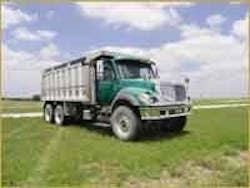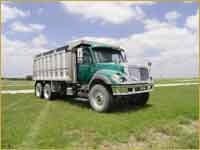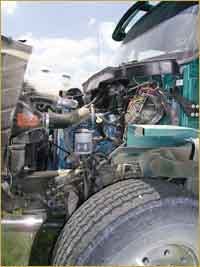International's 7500 Has New Power to Go and Slow
NASCAR fans might've appreciated it: A whole fleet of shiny new trucks running around the premises of the Texas Motor Speedway north of Dallas while race cars roared around the track. But this wasn't a race weekend, so fans were absent from the stands and luxury boxes, and the non-stock "stock cars"—NASCAR's middle name, isn't it?—were only practicing.
Off the track, about 200 dealers and customers and a handful of truck writers took turns at the wheels of the trucks, appraising their comfort, handling and power. International is a NASCAR sponsor, so executives picked this place to show off the vehicles on a sunny day in mid-May, to the pleasure of the participants.
The vehicles were the latest iterations of International Truck & Engine's 4000, 7000 and 8000 Series medium- and heavy-duty trucks and tractors powered by its own engines. The "green" diesels were recently redesigned to comply with the latest government exhaust emissions regulations, which took effect in January.
The speedway's extensive grounds encompass miles of paved streets, which the on-highway 4000s and 8000s stuck to, and acres of gravel-and-grass parking, which the severe-service 7000s crisscrossed. On the off-road course, there were holes and piled-up dirt for us to go through and over; some of the mounds were closely spaced moguls, which shook the devil out of the trucks and drivers who hit the bumps too fast. Air-ride seats bottomed out and we had to hang on, and yeah, it was fun.
I've driven several 7000 Series trucks since their introduction at this same speedway about three years ago, when they replaced the old severe-service 2000 Series. Basically, the 7000 uses the 4000's steel cab and fiberglass nose placed on a high-strength frame. All elements are beefed up to take the pounding of on/off-road duties. The cab is well appointed with an automotive-style dashboard, easily understood gauges and controls, and room enough for three-across seating if you need it.
The 7000s are built in Garland, a Dallas suburb, along with the premium 5000i severe-service trucks. Even with single rear axles, most 7000s are rated as Class 8 trucks by virtue of heavy-duty frames and components. The 7300 and 7400 get International's DT 466, and the 7400 can also get the DT 570. The 7500 gets the HT 570, which recently replaced the 530. Not present this day were 7600s with their 11- and 13-liter Cummins and Cat diesels.
Extensive revisions to International's in-line six-cylinder diesels for '04 include an electronically controlled variable-geometry turbocharger whose vanes adjust to optimize boost across the operating range; cooled exhaust-gas recirculation to reduce EPA-regulated oxides of nitrogen; and a Generation 2 electro-hydraulic fuel system, a common rail design with no high-pressure external lines and smaller injectors that provide room for four valves per cylinder, for a complete mix of fuel and air.
Optional on the 466 and 570 are Diamond Logic exhaust and engine brakes. The exhaust brake uses the turbo's vanes to introduce back pressure, and develops up to 120 retarding horsepower in a 466 and 230 horsepower in a 570. The engine brake uses the turbo-induced back pressure and adds hydraulically actuated valve action on all six cylinders to increase compression. It makes up to 250 retarding horsepower in a 570, International engineers said.
Although I drove about a half-dozen different vehicles, I latched onto this 7500 10-wheel Integrated Dump Truck, with its big J&J aluminum body, because it had both a new HT 570 diesel and the exhaust/engine brake. Several trips over the off-road course and a spin around the speedway's perimeter road at moderate highway speeds gave me a feel for these components. In short, the 570 really felt like it had 50 more cubic inches than its predecessor, and the brake showed decent retarding ability along with impressive quietness.
The HT (for high-torque) 570 (for its displacement in cubic inches) was rated at 340 horsepower and 1,150 pounds-feet of torque—pretty healthy for a 9.3-liter diesel, and right in the same league as Cat's C9 and Cummins' ISL, which are not offered by International. With a higher capacity cooling package, the HT 570 will eventually grow to 370 horsepower and 1,450 pounds-feet, engineers said.
Low-end boost from variable geometry turbo and bigger displacement from lengthening the stroke of the old 530 made the 570 feel more like a 10-liter engine. It was pleasingly lively as I rowed through the gears while trundling through the off-road course. Coming out of corners it would accelerate from 900 rpm and it felt strong from the 1,100-rpm torque peak on up to its 2,200-rpm limit. I usually upshifted at 1,800 or less, and it behaved like a big-bore engine.
The truck had a Fuller 13-speed transmission running through "slow" 5.29 differentials. This gave the tranny's low ratios sufficient startability for the mostly on-road service this 10-wheeler is likely to see. With a load of dirt in the box, I usually used 2nd or 3rd gear to start out. If the truck had been set up with one or two pusher axles for heavier loads, the popular Fuller 8LL with its range of low-low ratios might have been a better choice. The gearshift lever operated fine in this and other trucks, but in one truck the lever felt sticky, maybe because it needed some adjustment.
While watching other trucks being driven during the course of the day, I noticed that smoke puffed out of their tail pipes while their engines idled and sometimes during gear shifts. A later query to International's Engine Division got me the explanation that these engines were pre-production versions tuned for the proper advertised performance, but some weren't yet certified for emissions. Engines now coming off the assembly lines should be visibly smokeless.
The Diamond Logic exhaust brake feels and acts somewhat like a Jake Brake, and the two dash-mounted rocker switches are also familiar: one for on-off, and the other for retarding levels 1, 2 and 3. Those three positions don't run the valves of two, four or six cylinders, as does a Jake, but brings the vanes of the variable-geometry turbocharger into play and adjusts their angle. So it's not a one-third, two-thirds action at levels 1 and 2, but more like 30 and 70 percent, an engineer explained.
This is due to the brake's function, which starts with valve action that heightens compression, then engages the turbo to build back pressure. There's no valve popping as with a Jake and no "potato in the pipe" muffling as with an exhaust brake, either. In fact, there's little sound at all. Engineers claim it's quieter than the sound of the engine idling. I didn't have a decibel meter to verify that, but it really is almost whisper quiet, and might allow drivers to sneak its use even where engine brakes are banned.
Some people think that some signs, which specifically forbid use of "Jake Brakes," would legally allow use of this device. Maybe, but "Jake" has become generic for any engine brake. Meanwhile, Jacobs Manufacturing has aggressively sought to protect the trademarked name of its product, even to the point of sending written protests to municipalities that have specifically outlawed Jakes and printed the name on signs. Anyway, I doubt that police officers will hear the Diamond Logic brake operating, and its use does save the service brakes for more serious situations.
The engine/exhaust brake will be helpful on long downgrades, but of course there aren't many of those in northern Texas and none on the grounds of the speedway. All I could do is engage the brake on level pavement and let it pull down the truck's speed, as a driver might do in heavy traffic. The Diamond brake worked gently, and maybe its quietness masks its power.
Any racetrack elicits thoughts of speed and excitement, which are not exactly synonymous with workaday trucks like this 7500 dumper, unless you have a hand in designing, building and selling them. Many attendees at this event do, so were generous with their cheers and praise of these products. Some dealers, happy at what they saw, purchased several of the demo trucks on the spot.
Drivers and owners tend to be more sober about a truck that's built to move dirty loads in grimy surroundings. If a reasonably priced truck can do this with reliability, dispatch and comfort, great. The nicely thought-out 7500 does, and the HT 570 with Diamond Logic brake adds performance that drivers will appreciate and potential owners might well consider, and maybe even get excited about.



